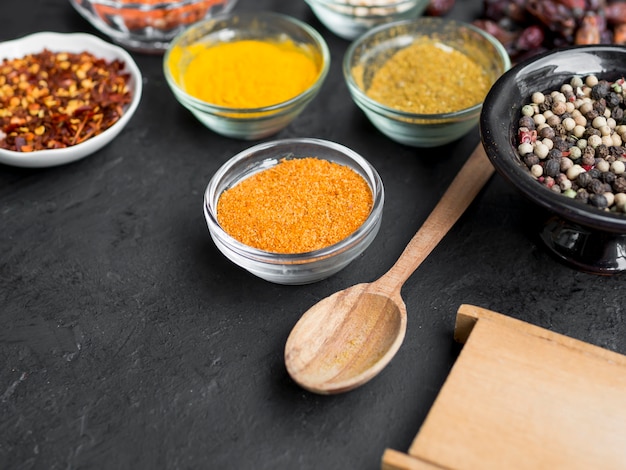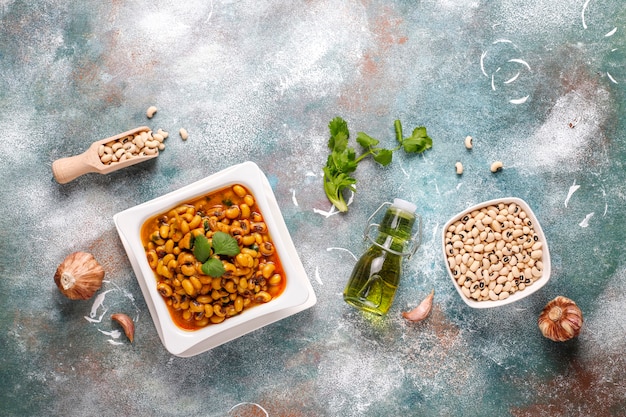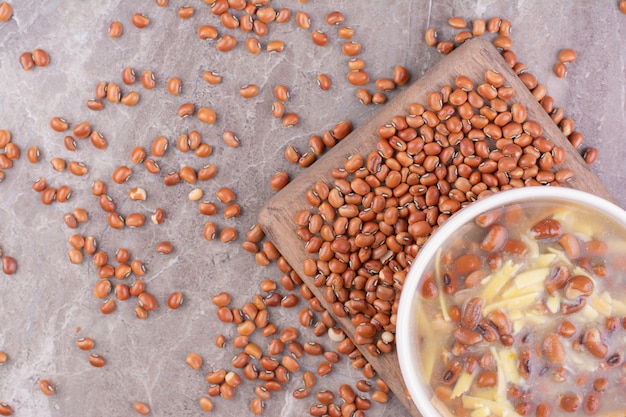Let's face it, lentils often get a bit of a bad rap. They're seen as bland and boring, a bit of a culinary afterthought. But I'm here to tell you that couldn't be further from the truth! These humble legumes are incredibly versatile, packed with nutrients, and can be the star of many delicious dishes.
However, the key to unlocking their full potential lies in knowing how to cook them properly. It's not just about throwing them in a pot and hoping for the best. There's a real art to achieving that perfect texture – tender but not mushy – which can transform a simple lentil dish into a culinary masterpiece.
As a seasoned cook, I've spent years experimenting with lentils, trying out different types, techniques, and recipes. And through trial and error, I've learned some valuable lessons I'm eager to share.
So, grab a comfy seat, brew a cuppa, and let's delve into the world of lentil cooking, together.
(Part 1) The Lentil Landscape: A Beginner's Guide

The first step on our lentil journey is understanding the different types available. Think of it like a family reunion: each member has its own personality and quirks, making them suitable for specific dishes.
1. brown lentils: The Workhorse
Brown lentils are the most common type, the reliable workhorse of the lentil world. They hold their shape beautifully after cooking, making them perfect for hearty salads, robust soups, and even veggie burgers. And they’re a fantastic source of fibre and protein, making them a great choice for a healthy diet.
2. green lentils: The French Fancy
Green lentils, also known as french lentils, boast a firmer texture and slightly earthy flavour. They’re often used in traditional french cuisine, lending a rustic charm to salads, soups, and even side dishes.
3. red lentils: The Split Wonders
Red lentils, or split red lentils, are the smallest and fastest-cooking members of the lentil family. Their key characteristic is that they break down during cooking, creating a creamy texture ideal for flavourful soups, curries, and daals.
4. black lentils: The Fancy Black Lentils
Black lentils, or beluga lentils, are named after the black caviar due to their small, shiny, almost black appearance. They hold their shape beautifully after cooking, making them perfect for salads, side dishes, and even a lentil "risotto" that's both visually appealing and delicious.
5. yellow lentils: The Indian Delight
Yellow lentils, or split yellow lentils, cook up in a flash and are a staple in Indian cuisine, often used in daals and curries. They're known for their creamy texture and ability to absorb flavours beautifully.
(Part 2) Understanding the Cooking Process

Now that we know our lentil family, let's tackle the cooking process itself. It's all about finding that sweet spot between tender and mushy. Here's a breakdown of the key points to keep in mind.
1. The Right Ratio: Water to Lentils
The general rule of thumb is a 3:1 ratio – 3 cups of water for every 1 cup of lentils. However, this can vary depending on the lentil type and your desired consistency. For example, if you want a thicker soup, you may want to reduce the water slightly.
2. Salt and Sugar: Timing is Key
One common mistake is adding salt to the water before the lentils start cooking. This can actually make them tough and prevent them from softening properly. The best approach is to add salt towards the end of cooking, once the lentils are tender.
As for sugar, some cooks add a pinch to the cooking water to help with texture. I personally find it unnecessary, but feel free to experiment and see what works best for you.
3. Keeping an Eye on the Pot: Don't Walk Away
Lentils cook relatively quickly, so it's important to keep a close eye on them and stir occasionally to prevent sticking.
(Part 3) Cooking Times: A Guide to Each Lentil Type

Now comes the fun part - knowing how long to cook each type of lentil for that perfect texture. Remember, these are just guidelines, and the actual cooking time can vary depending on your pot, stovetop, and the amount of lentils you're using.
1. Brown Lentils: The Steady Cooker
Brown lentils typically take around 20-30 minutes to cook. Keep an eye on them, and if you want a firmer texture, you can remove them from the heat a couple of minutes before they reach full tenderness.
2. Green Lentils: The Firmer Friend
Green lentils require a bit more time, around 25-35 minutes. They'll maintain their shape well, but it's important to make sure they're fully cooked to avoid a crunchy bite.
3. Red Lentils: The Speedy Star
Red lentils are the speed demons of the lentil world, cooking up quickly in just 15-20 minutes. Their cooking time is often reduced due to their split nature, which allows them to absorb water more readily.
4. Black Lentils: The Black Beauty
Black lentils, like green lentils, need around 25-35 minutes to reach tenderness. Their firm texture and dark colour make them visually stunning in salads and side dishes.
5. Yellow Lentils: The Quick Fix
Yellow lentils are the fastest cooks of the bunch, taking only 10-15 minutes. They're perfect for those evenings when you need a quick and easy meal.
(Part 4) Beyond the Pot: Exploring Different Cooking Methods
Let's be honest, sometimes you want a faster and more convenient method than the trusty stovetop. Here are a few other ways to cook your lentils to perfection.
1. The pressure cooker: A Time-Saver
A pressure cooker is a game-changer when you're short on time. Brown lentils cook in about 5-7 minutes in a pressure cooker, green lentils in around 8-10 minutes, and red lentils in just 3-5 minutes. It's a real lifesaver for busy weeknights.
2. The slow cooker: A Set-and-Forget Wonder
Slow cookers are ideal for a hands-off approach. Simply add your lentils, broth, and any other ingredients to the slow cooker, set it on low, and let it work its magic for 4-6 hours. It's a perfect way to create a comforting and flavourful meal with minimal effort.
3. The instant pot: The Ultimate Convenience
The Instant Pot combines the best of both worlds – pressure cooking and slow cooking, all in one handy appliance. It's a great tool for cooking lentils quickly and with minimal fuss. Brown lentils typically cook in 10-15 minutes, green lentils in 12-15 minutes, and red lentils in 5-8 minutes.
(Part 5) Testing for Doneness: The Texture Check
Now, how do you know when your lentils are ready to go? It's all about the texture.
1. The Bite Test
Take a lentil out of the pot and give it a gentle bite. It should be tender, but not mushy. It should still hold its shape, but not be too hard.
2. The Spoon Test
If you're making a soup or stew, try scooping some up with a spoon. If the lentils slide off the spoon easily, they're done. If they stick to the spoon, they need a bit more cooking.
(Part 6) Beyond the Basics: Adding Flavor
Now that you've mastered the art of lentil cooking, it's time to unleash your creativity and explore the exciting world of flavour. There are endless possibilities to transform your lentil dishes from basic to brilliant.
1. Herbs and Spices: A World of Flavors
Lentils are wonderfully versatile and complement a wide range of herbs and spices. Think cumin, coriander, turmeric, garlic, onion, rosemary, thyme, paprika, and bay leaves. Experiment with different combinations to create your own unique flavour profiles.
2. Veggies and Greens: Adding Color and Texture
Lentils love to mingle! Add your favourite vegetables like carrots, celery, bell peppers, onions, spinach, kale, or even mushrooms. They add colour, texture, and extra nutrients to your lentil dishes.
3. Lemon Juice or Vinegar: A Bright Finish
A squeeze of lemon juice or a splash of vinegar can brighten up the flavours of lentil dishes, adding a tangy twist. This is especially effective for salads or soups.
4. Toasted Nuts and Seeds: A Crunchy Delight
Toasted nuts and seeds, like almonds, walnuts, pumpkin seeds, or sunflower seeds, provide a wonderful textural contrast to the soft lentils. They also add a boost of healthy fats and protein.
(Part 7) Lentil Leftovers: A Culinary Treasure Trove
Don't be afraid of leftovers! Lentils are a fantastic ingredient for meal prepping, making your life easier during the week. They can be easily reheated and used in various ways.
1. lentil salads: A Light and Refreshing Option
Leftover lentils can be tossed with chopped vegetables, herbs, and a light vinaigrette to create a delicious and nutritious salad. They make a great lunch or light dinner option.
2. lentil soup: A Hearty and Comforting Meal
Leftover lentils can be added to a soup for extra protein and fiber. They'll thicken the soup and add a satisfying heartiness.
3. Lentil Burgers: A Veggie Delight
Leftover lentils can be combined with spices, oats, and breadcrumbs to create veggie burgers. They're a great way to add some variety to your veggie burger repertoire.
4. Lentil Dip: A Party Favorite
Leftover lentils can be blended with hummus or other dips to create a tasty and healthy snack. They'll add a unique texture and a protein boost to your dip.
(Part 8) Lentils and Health: A Nutrient Powerhouse
Beyond being delicious and versatile, lentils are a true nutritional powerhouse. They're packed with fiber, protein, and various vitamins and minerals.
1. High in Fiber: Keeping You Regular
Lentils are an excellent source of fiber, which aids in digestion and helps you feel full and satisfied. This makes them a great choice for weight management and overall gut health.
2. Rich in Protein: A Vegetarian's Best Friend
Lentils are a fantastic source of plant-based protein, making them an excellent choice for vegetarians and vegans. They're a complete protein, meaning they contain all the essential amino acids your body needs.
3. Packed with Iron: Boosting Your Energy
Lentils are a good source of iron, which is crucial for carrying oxygen throughout the body. Iron deficiency can lead to fatigue, so including lentils in your diet is a great way to boost your energy levels.
4. Loaded with Folate: Essential for Pregnancy
Lentils are also rich in folate, which is essential for cell growth and development, especially during pregnancy. Folate deficiency can lead to birth defects, so it's vital to ensure adequate intake.
FAQs: Your Lentil Questions Answered
1. Can I use lentils straight from the package?
Yes, you can use lentils straight from the package without soaking them. However, soaking them for 30 minutes to an hour can help reduce cooking time and make them easier to digest.
2. Should I rinse lentils before cooking?
Yes, it's always a good idea to rinse lentils before cooking to remove any debris or dust. This will also help to prevent a muddy flavour in your dish.
3. How can I make lentils less gassy?
Lentils contain complex sugars that can cause gas in some people. To reduce gas, you can soak them for several hours before cooking, or add a pinch of baking soda to the cooking water.
4. What happens if I overcook lentils?
Overcooked lentils will become mushy. It's best to keep a close eye on them and test for doneness frequently.
5. Can I freeze cooked lentils?
Yes, you can freeze cooked lentils for up to 3 months. To freeze them, let them cool completely, then transfer them to a freezer-safe container or bag.
Remember, lentils are a culinary treasure waiting to be discovered. Don't be afraid to experiment with different types, flavours, and cooking methods. From hearty soups to satisfying salads, lentil dishes are a delicious and healthy addition to any meal. Enjoy!
Everyone is watching

Corn on the Cob: The Ultimate Guide to Perfectly Cooked Ears
Healthy MealsAh, corn on the cob. Just the name evokes images of sunny days, barbecues, and that sweet, juicy flavour that ...

Perfect Pork Roast Oven Cooking Time: A Guide to Delicious Results
Healthy MealsThere's something truly satisfying about a perfectly roasted pork. The aroma alone is enough to make your mout...

Scallops: The Ultimate Guide to Perfect Cooking
Healthy MealsAh, scallops. Those delicate, sweet, and utterly delicious morsels of the sea. They hold a special place in my...

Ham Cooking Time: How Long to Bake, Smoke, or Boil a Delicious Ham
Healthy MealsAh, ham. It's a classic, isn't it? A real crowd-pleaser, especially around holidays. And when done right, it'...

Spaghetti Squash: The Ultimate Guide to Cooking and Serving
Healthy MealsRemember that time you saw spaghetti squash at the supermarket, looking all bumpy and strange, and thought, "W...
